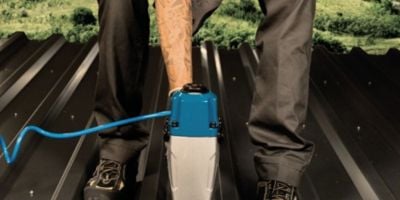When it comes to protecting your home from extreme weather conditions, having a durable metal roof is crucial. Metal roofs are known for their longevity and ability to withstand even the harshest elements. Unlike other roofing materials, metal roofs are resistant to rot, mildew, and insect damage.
In addition to their durability, metal roofs are also energy efficient. They can reflect solar heat, reducing the need for air conditioning and lowering your energy bills. Metal roofs are also recyclable, making them an environmentally friendly choice for homeowners.
Overall, investing in a durable metal roof is a wise decision that can provide long-lasting protection for your home and save you money in the long run. It’s also important to invest in installation and maintenance tools and fasteners, such as the BECK SCRAIL® RoofLoc® System, to ensure it is installed properly.
Exploring the Different Types of Metal Roofing Materials
There are several different types of metal roofing materials to choose from, each with its own unique benefits and characteristics. Some of the most popular options include steel, aluminum, and copper.
Steel is a common choice for metal roofing due to its strength and affordability. It is highly durable and can withstand extreme weather conditions. Steel roofs are available in a variety of styles, including corrugated panels and standing seam systems.
Aluminum is another excellent choice for metal roofing. It is lightweight, corrosion-resistant, and suitable for coastal areas where saltwater exposure is a concern. Aluminum roofs are available in a range of colors and can be painted to match your home's exterior.
Copper is a premium metal roofing material known for its beauty and durability. It develops a natural patina over time, giving it a unique and elegant appearance. Copper roofs are long-lasting and can last for over 100 years with proper maintenance.
When choosing a metal roofing material, consider factors such as your budget, climate, and desired aesthetic to ensure you select the most suitable option for your home.
Comparing the Strength and Durability of Metal Roofing Options
When it comes to the strength and durability of metal roofing options, it is important to consider factors such as gauge, coating, and installation methods.
The gauge refers to the thickness of the metal. A lower gauge number indicates a thicker and more durable material. For example, a 24-gauge steel roof is stronger than a 29-gauge steel roof.
Coating plays a crucial role in protecting the metal from corrosion and extending its lifespan. Common coatings include galvanized steel, galvalume steel, and aluminum-zinc alloy. Each coating has its level of resistance to rust and corrosion.
The installation method also affects the strength and durability of a metal roof. Standing seam roofs, where the panels interlock and are secured with concealed fasteners, are known for their exceptional wind resistance and durability.
By comparing these factors, you can determine which metal roofing option offers the best combination of strength and durability for your specific needs.
Factors to Consider When Choosing the Most Durable Metal Roofing
Choosing the most durable metal roofing involves considering various factors to ensure you make the right decision for your home.
One important factor is the climate in which you live. If you experience extreme weather conditions such as heavy snowfall or high winds, you need a metal roof that can withstand these challenges. Look for metal roofs with high wind ratings and snow load capacities.
Another factor to consider is the slope of your roof. Different metal roofing materials have different minimum slope requirements. Make sure to choose a metal roof that is suitable for the pitch of your roof to ensure proper water drainage and prevent leaks.
Additionally, consider the warranty offered by the manufacturer. A longer warranty period indicates that the metal roof is expected to last for a longer time. Pay attention to the terms and conditions of the warranty to understand what is covered and what is not.
Lastly, consult with a professional roofing contractor who can assess your specific needs and recommend the most durable metal roofing option for your home.
Maintenance Tips to Extend the Lifespan of Your Metal Roof
To ensure your metal roof remains durable and long-lasting, regular maintenance is essential. Here are some tips to extend its lifespan:
- Inspect your roof at least twice a year and after severe weather events to check for any damage or loose panels. Repair any issues promptly to prevent further damage.
- Keep your roof clean by removing any debris, such as leaves or branches, that can accumulate and trap moisture. Use a soft-bristle brush or a leaf blower to remove the debris gently.
- Trim overhanging tree branches to prevent them from rubbing against the roof and causing scratches or damage.
- Clean the gutters and downspouts regularly to ensure proper water drainage. Clogged gutters can lead to water buildup, which can damage the roof.
- Avoid walking on the roof unnecessarily to prevent denting or scratching the metal surface. If you need to inspect or perform maintenance on the roof, use a ladder or hire a professional.
To ensure your metal roof will last, it's important to use the right fasteners. The SCRAIL® RoofLoc® nail screw can be installed eight times faster than bulk screws and twice as fast as collated screws saving on installation time. They include an EPDM sealing washer for UV-resistant, leakproof, and secure fastening. The SCRAIL® RoofLoc® is pneumatically driven with the FASCO® (a BECK brand) RoofLoc® installation tool and can be completely unscrewed for repair work.
When considering all of your options, and making sure the SCRAIL® RoofLoc® System is used, you can maximize the lifespan of your metal roof and enjoy its durability for many years to come.
.svg.png)


